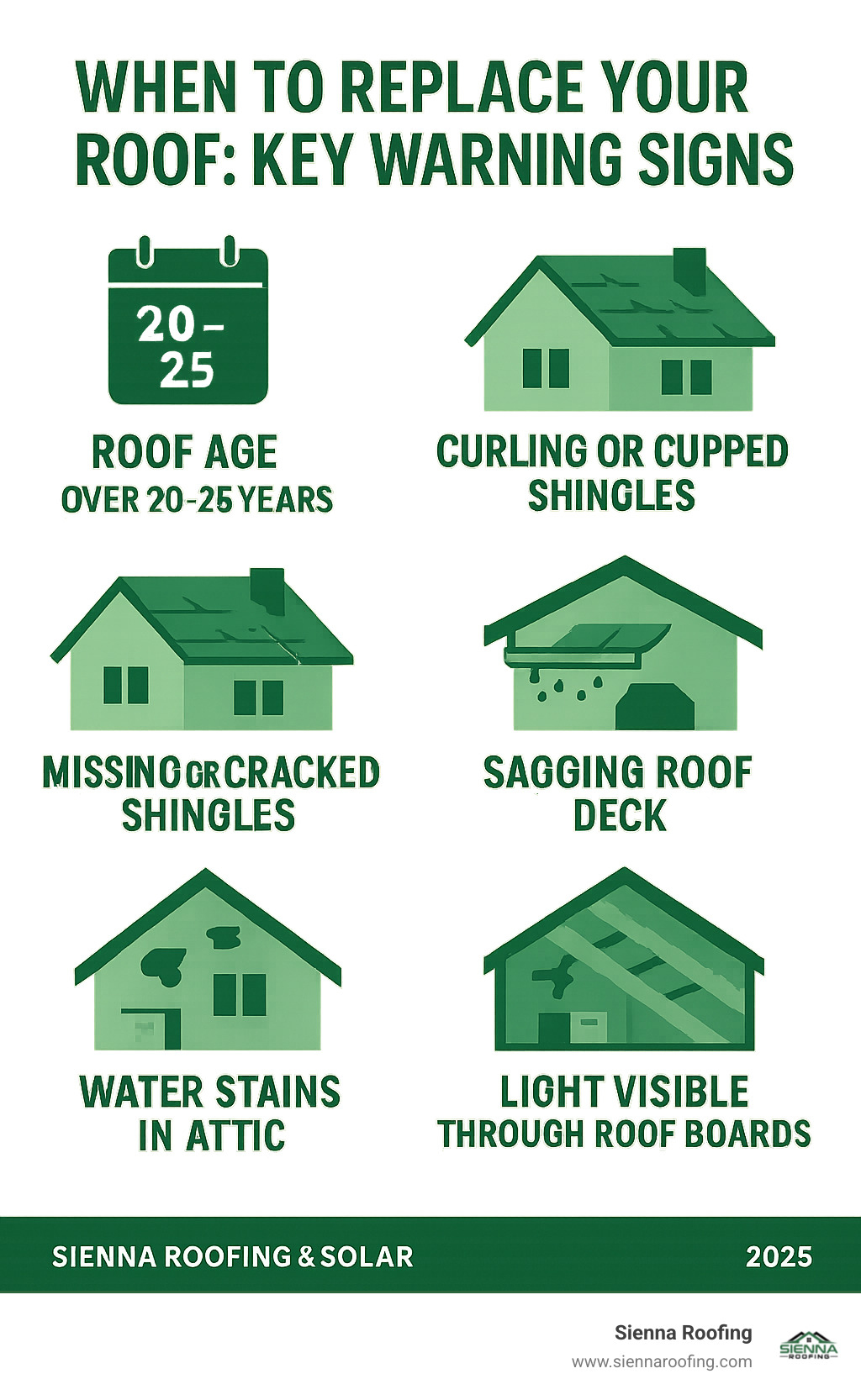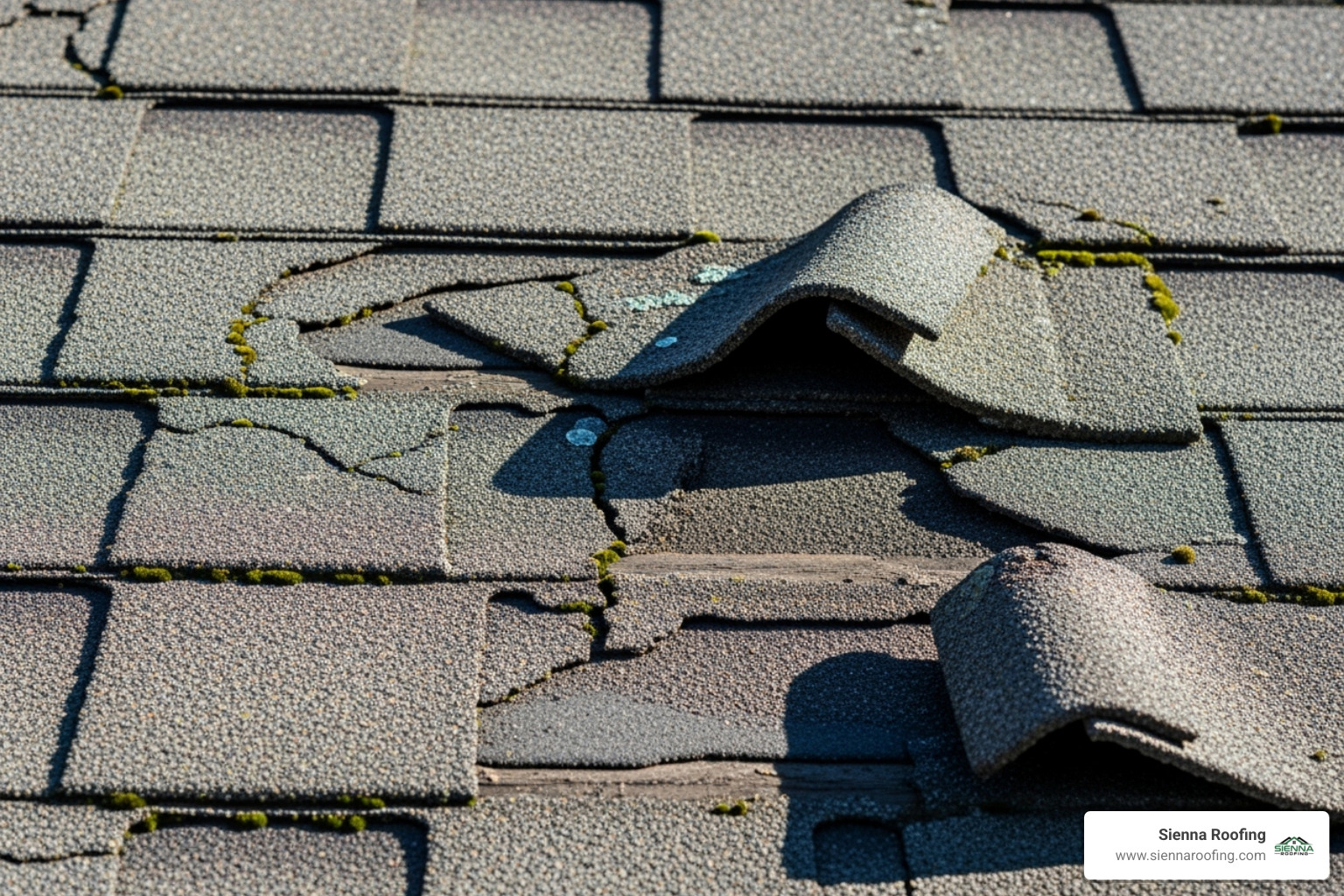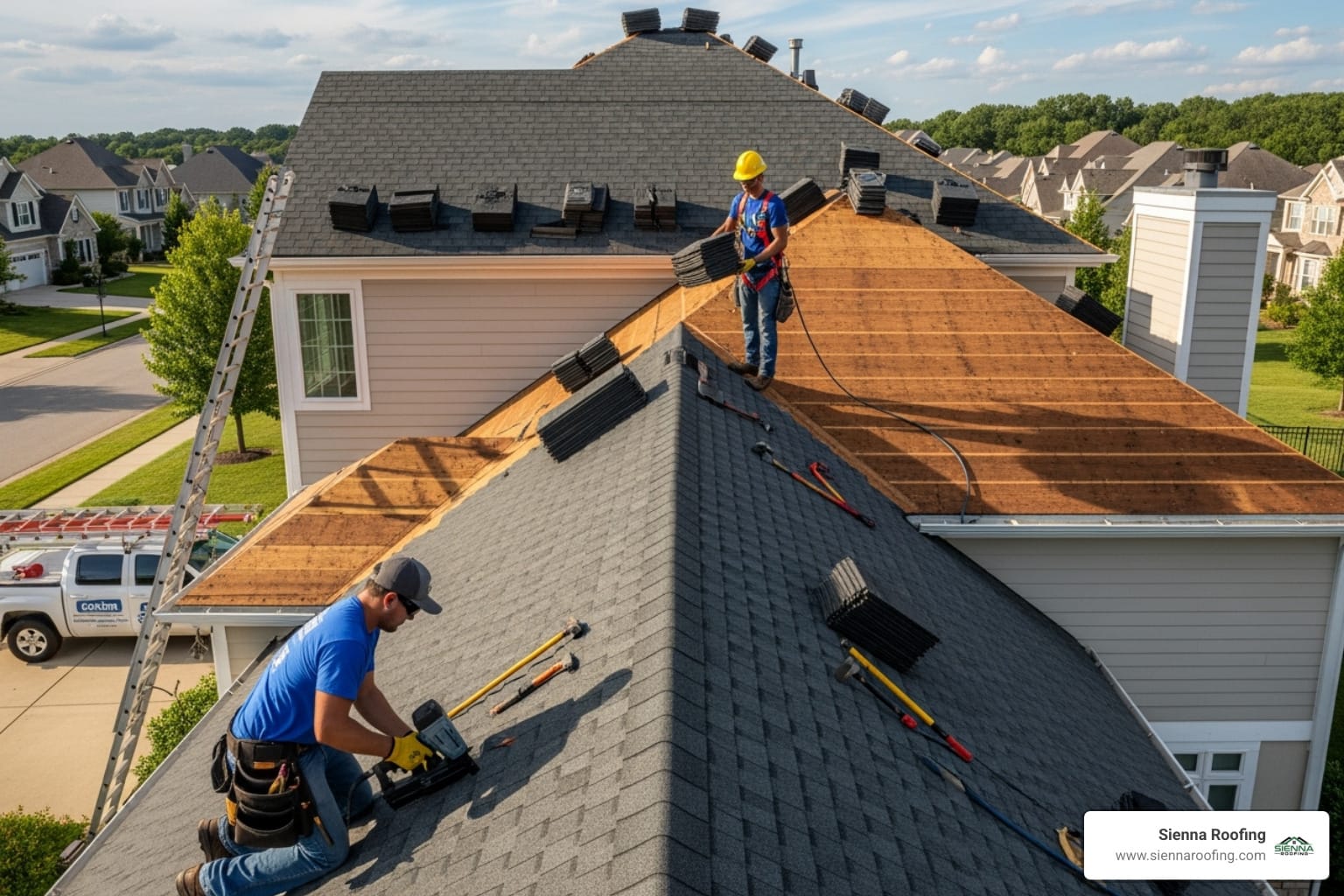Why Your Home Deserves a Quality Roof Replacement
A roof replacement is a significant home improvement investment, but it’s also one of the most important for protecting your property and family. Whether you’re dealing with storm damage, an aging roof, or simply want to upgrade your home’s protection, understanding the process helps you make informed decisions. As your trusted partner for roofing and solar solutions in Houston, we’ve created this guide to walk you through everything you need to know.
Your roof is your home’s first line of defense against Texas weather. A quality replacement not only protects your investment but can also improve energy efficiency and boost your home’s value.
I’m Andre Castro, CEO and founder of Sienna Roofing & Solar. With a background in Construction Management from Texas A&M, I’ve personally overseen hundreds of roof replacement projects across the Houston Metro area. My hands-on approach ensures every installation meets the highest standards for quality and durability.

Roof replacement basics: Proper ventilation, high-quality materials, and expert craftsmanship are key to a long-lasting roof.
When to Replace Your Roof: Key Warning Signs
Most roof replacement projects become necessary when homeowners recognize the telltale signs that their roof’s protection is failing. The good news? These warning signs are usually obvious once you know what to look for.
- Age: If your asphalt shingle roof is 20-25 years old, it’s entering retirement age. Even if it looks okay, the materials are likely losing their effectiveness. Metal roofs last 40+ years, while tile and slate can last 50-100 years.
- Visible Shingle Damage: Walk around your property and look up. Curling or cupped shingles show age and weathering. Missing or cracked shingles are a clear sign of failure, leaving the underlying structure exposed to Texas weather.

- Granules in Gutters: Those sand-like particles are the protective coating from your shingles. If your gutters are full of them, your roof is losing its armor against UV rays and water. This also leads to bald spots on shingles.
- Attic Issues: Check your attic for water stains on ceilings or walls. If you can see daylight coming through the roof boards, water can definitely get in.
- Structural Problems: A sagging roof deck is a serious issue that needs immediate attention, as it indicates potential structural damage from prolonged water intrusion.
- Growth on the Roof: In Houston’s humid climate, moss or algae growth is common. It traps moisture against your shingles, speeding up deterioration.
If you’re seeing these signs, especially after a storm, it’s time for a professional inspection. Catching these issues early can prevent a small problem from becoming a major expense. When in doubt, a free inspection from a reputable contractor provides an honest assessment of your roof’s condition.
Understanding Roof Replacement Costs and Materials
When you’re facing a roof replacement, understanding the financial investment is crucial for making informed decisions. The cost of replacing your roof varies significantly based on several factors, but having realistic expectations helps you budget appropriately.
Nationally, roof replacement costs typically range from $7,000 to $24,000, with most homeowners spending between $15,000 and $18,000 in 2024. For a standard 2,000-square-foot home with asphalt shingles, you can expect to pay between $3 and $6 per square foot for materials and installation. However, when you consider all roofing materials, the range expands to $4 to $11 per square foot.
Several key factors influence your final roof replacement cost. Roof size and pitch are primary considerations – larger roofs naturally require more materials and labor, while steeper or more complex rooflines with multiple angles, valleys, or dormers increase both installation time and safety requirements, driving up costs.
Labor costs represent a significant portion of your investment, often accounting for up to 60% of the total expense. These costs vary considerably by region. While areas like Arizona and California see higher costs ranging from $10,000 to $28,000, and Arkansas sees lower costs from $2,500 to $9,000, Texas offers competitive rates. Here in the Houston Metro area, our pricing reflects local market dynamics while maintaining exceptional value.
Material choice serves as one of the biggest cost drivers, typically accounting for 40% to 50% of total costs. Finally, don’t forget about permit fees – most roof replacement projects require local permits to ensure building code compliance, typically ranging from $75 to $500.
For homeowners seeking a comprehensive understanding of pricing factors, we provide a detailed breakdown of roofing costs that covers all aspects of your investment.
Common Roofing Materials for Your Home
Choosing the right roofing material involves balancing aesthetics, durability, lifespan, and cost to find the perfect fit for your home and budget.
Asphalt shingles remain the most popular choice for good reason – they offer excellent affordability and versatility. These shingles provide reliable protection while fitting most budgets, making them an ideal choice for many homeowners. Professionally installed asphalt shingles ensure maximum longevity.
Metal roofing has gained popularity due to its exceptional durability and energy efficiency. While the initial investment is higher, well-installed metal roofs can last 40+ years and significantly reduce cooling costs in Texas heat.
Tile and slate roofing represent the premium end of roofing materials, offering best longevity and aesthetic appeal. These materials can last 50-100+ years when properly maintained, making them excellent long-term investments despite higher upfront costs. Expertly installed tile or slate roofs are built to last generations.
For comprehensive guidance on material selection, explore our comprehensive guide to 2025’s best roofing materials, which covers the latest innovations and recommendations.
| Material Type | Cost per Sq. Ft. (Installed) | Lifespan | Pros | Cons |
|---|---|---|---|---|
| Asphalt Shingles | $4.00 | 20-25 years | Affordable, versatile, easy to install | Shorter lifespan, weather-sensitive |
| Metal | $10.50 | 40+ years | Durable, energy-efficient, fire-resistant | Higher upfront cost, potential noise |
| Tile | $16.00 | 50-100+ years | Extremely durable, beautiful, fire-resistant | Heavy, expensive, requires structural support |
| Slate | $16.50 | 50-100+ years | Longest lasting, natural beauty, fire-resistant | Very expensive, heavy, difficult repairs |
Additional Costs to Consider in Your Budget
Beyond the basic materials and labor, several additional costs can impact your roof replacement budget. Planning for these expenses prevents surprises and ensures your project stays on track.
Old roof removal and debris disposal are often necessary first steps. While some roofing systems allow for overlay installation, complete tear-off is usually recommended for best results and longevity.
Underlayment and decking repairs may be required once the old roof is removed. Water damage or structural issues found during tear-off need immediate attention to ensure your new roof has a solid foundation.
Flashing replacement around chimneys, vents, and roof penetrations is crucial for preventing leaks. Quality flashing installation protects the most vulnerable areas of your roof system.
Skylights or chimney work may be necessary if these features need updating or repair during the replacement process. Inspection fees and potential structural repairs round out the additional considerations that ensure your new roof provides decades of reliable protection.
Understanding Roof Replacement Costs and Materials
When you’re considering a roof replacement, understanding the investment helps you plan effectively. Nationally, homeowners typically spend between $7,000 and $24,000, with most projects in the $15,000 to $18,000 range. Here in the Houston Metro area, several key factors influence your final cost:
- Roof Size and Pitch: Larger or steeper roofs require more materials and labor, increasing the cost.
- Labor Costs: This can be up to 60% of your total project expense and varies by region.
- Material Choice: Your choice of material is a significant cost driver, making up 40% to 50% of the total.
- Permit Fees: Most projects require local permits, typically ranging from $75 to $500.
For a comprehensive breakdown of all financial aspects, explore our detailed guide at how much does a new roof cost.
Common Roofing Materials for Your Home
Choosing the right material involves balancing durability, appearance, lifespan, and budget. Here are the most popular options.
| Material Type | Cost per Sq. Ft. (Installed) | Lifespan | Pros | Cons |
|---|---|---|---|---|
| Asphalt Shingles | $3.50 – $6.00 | 12-30 years | Affordable, versatile, easy to install | Shorter lifespan, less durable in extreme weather |
| Metal Roofing | $5.00 – $16.00 | 40-75 years | Extremely durable, energy-efficient, recyclable | Higher upfront cost, can be noisy during rain |
| Tile (Clay/Concrete) | $7.00 – $25.00 | 50-100+ years | Very durable, fire-resistant, beautiful | Heavy (may require structural reinforcement), brittle, expensive |
| Slate | $10.00 – $30.00 | 50-150+ years | Exceptional longevity, neat appearance | Very heavy, very expensive, requires specialized installation |
Asphalt shingles are the favorite for their affordability and versatility. Metal roofing has gained popularity for its exceptional durability and energy efficiency, a significant benefit in our Texas climate. Tile and slate roofing represent the premium end, offering stunning aesthetics and lifespans that can exceed 100 years, though their weight may require structural reinforcement.
For detailed guidance on which material best suits your needs, we’ve created a comprehensive guide to 2025’s best roofing materials.
Additional Costs to Consider in Your Budget
A complete roof replacement budget extends beyond materials and labor. Be prepared for potential additional costs:
- Old Roof Removal & Disposal: Tearing off the old roof and disposing of the debris.
- Decking Repairs: Replacing any rotted or damaged wood found after tear-off.
- Underlayment & Flashing: Installing a new waterproof barrier and metal flashing around chimneys, vents, and valleys.
- Structural Repairs: In rare cases, significant water damage may require repairs to the roof’s trusses or rafters.
Your Complete Guide to the Roof Replacement Process
Getting a roof replacement can feel overwhelming, but understanding the process makes it much smoother. Most projects take 1 to 4 days, depending on your home’s size, complexity, and the weather. We take care to protect your property by using tarps to shield landscaping and performing a thorough cleanup with magnetic sweepers to collect stray nails.

Step 1: Removing the Old Roof and Inspecting the Deck
The first step is stripping away the old roof down to the bare wooden deck. This allows for a crucial inspection where we look for any rot, water damage, or structural problems. Any damaged sections of decking are replaced to ensure your new roof has a solid, stable foundation.
Step 2: Preparing the Roof for New Materials
With a clean deck, we begin preparations. This includes installing a self-sticking ice and water shield in vulnerable areas like valleys and eaves. Then, new underlayment (a secondary waterproof barrier) is rolled out across the entire roof. Finally, metal drip edge is installed to direct water into the gutters.
Step 3: Installing the New Roofing System
Now the new roof takes shape. We start at the bottom and work our way up, installing each shingle or panel with precise nailing and overlapping. We install new flashing to create watertight seals around chimneys, vents, and skylights. To finish, we install ridge caps and new vents to ensure proper attic ventilation, which extends your roof’s lifespan. Our team follows a strict professional roof installation process and adheres to all local building codes and regulations.
Step 4: Final Cleanup and Inspection
Our job isn’t done until your property is spotless. We conduct a thorough cleanup, removing all debris. We then perform a final walkthrough with you to answer any questions and ensure your complete satisfaction. You’ll receive all warranty documentation for both materials and our labor, giving you peace of mind for years to come.
Roof Replacement vs. Repair: Making the Right Choice
Homeowners often ask: “Do I need a full roof replacement, or can I just get a repair?” The right choice depends on a few key factors.
When to Repair: If your roof is relatively young (under 15 years old) and the damage is isolated—like a few missing shingles from a storm—a targeted repair is usually the most cost-effective option. Small repairs typically cost a few hundred to a thousand dollars.
When to Replace: If your roof is approaching the end of its 20-25 year lifespan, or if damage is widespread (e.g., from a major hailstorm), a full replacement is often the smarter long-term investment. While a repair is a temporary fix, a new roof provides a fresh start with comprehensive protection and a new warranty, which also boosts curb appeal and home value.
Reroofing (Overlay) vs. Tear-Off
You might hear about “reroofing”—installing new shingles over the old ones—as a way to save money. We almost always recommend a complete tear-off instead. An overlay adds excessive weight to your roof structure and any issues with the old roof (like bumps or curls) will show through the new layer. Most importantly, an overlay prevents us from inspecting the roof deck for hidden rot or structural damage. A full tear-off ensures your new roof is built on a solid foundation and that your manufacturer’s warranty remains valid.
How to Choose a Reputable Roofing Contractor

Choosing the right contractor for your roof replacement is as crucial as selecting quality materials. A great roofer brings expertise, reliability, and peace of mind to the project.
- Prioritize Local Expertise: Work with established companies that have a physical office in the Houston Metro area. They understand local climate challenges and building codes and will be around to honor warranties. Be wary of “storm chasers” who appear after severe weather with low prices and high-pressure tactics.
- Verify Licensing and Insurance: Your contractor must have general liability insurance and worker’s compensation. Ask to see current proof of both.
- Check Reviews and References: Look at independent sites like Google and the Better Business Bureau. A reputable contractor will also provide references from recent local projects.
- Get Detailed Quotes: Aim for at least three written estimates. A professional quote will break down all costs, including materials, labor, tear-off, and permits. A suspiciously low bid is a major red flag.
- Understand the Warranties: Ensure you get a strong warranty covering both the materials and the contractor’s workmanship.
Here are the essential questions to ask any potential contractor:
- Are you licensed and insured in Texas?
- How long have you been in business in the Houston area?
- Can you provide recent local references?
- What warranties do you offer on materials and workmanship?
- Will you provide a detailed written estimate?
- How do you protect my property and clean up debris?
- What is your timeline for the project?
- How do you handle unexpected issues like damaged decking?
Frequently Asked Questions About Roof Replacement
We understand that a roof replacement is a major decision. Here are answers to the questions we hear most often from homeowners in the Houston Metro area.
What is the best time of year for a roof replacement?
Late spring through early fall is generally the ideal time. The mild, dry weather helps materials like shingles seal properly and allows our crews to work safely and efficiently. While you might find better pricing in the off-season (winter), be prepared for a more flexible schedule due to potential weather delays.
Will my homeowner’s insurance cover a roof replacement?
It depends. Insurance typically does not cover replacement for a roof that is simply old and worn out, as this is considered routine maintenance. However, your policy will likely cover replacement if the roof sustains sudden damage from a “covered peril” like a hailstorm, high winds, or a fallen tree. Proving the damage is from a specific event is key, which is where a professional assessment is invaluable. We can help document the damage and guide you through the claims process.
How long does a new roof last?
The lifespan of your new roof depends heavily on the material you choose and proper maintenance.
- Asphalt Shingles: 20 to 25 years for standard shingles, up to 30 for architectural styles.
- Metal Roofs: 40 to 70+ years. They are extremely durable and excellent at handling Texas weather.
- Tile and Slate Roofs: 50 to 100+ years. These are premium, long-term investments often called “forever roofs.”
These are averages. Proper installation and regular maintenance are critical to maximizing any roof’s lifespan.
Your Partner for a Secure and Lasting Roof
A roof replacement is a major project, but with the right information and a trusted partner, it becomes a smooth process that protects your home for decades. Understanding the warning signs, costs, and materials empowers you to make the best decision for your property.
At Sienna Roofing, we’re more than just contractors—we’re your neighbors in Sugar Land and across the Houston Metro area, committed to providing personalized service with a 100% satisfaction guarantee. We specialize in high-quality roofing and solar solutions designed to withstand the Texas climate.
Whether you’re dealing with storm damage or an aging roof, our team is here to guide you. If you suspect your roof needs attention, don’t wait for a small problem to become a major headache.
Ready for a professional assessment? The team at Sienna Roofing is here to help. Contact us today to schedule your free inspection. We’ll provide an honest evaluation and help you determine the best path forward for your home and budget.




